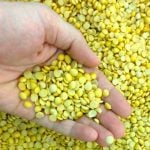
Tag Archives cover crops

Cover crops a challenge within existing production systems
Cover crops can exist with herbicide-tolerant canola, but results vary

Veggie production eyes cover crops
Eastern Manitoba experiment with cover cropping in vegetable production takes root

Making regenerative ag work in potato production
Colorado regen potato grower shares lessons for Manitoba

‘Little hammers’ control weeds on organic farm post-harvest
Tillage, grazing and cover crops make up organic post-harvest toolbox

Getting plants to do the tillage
Bio-strip tilling combines cover crop and strip-till philosophies

Soil health main focus of cover-croppers
Largest look into practice across Prairies at the farm level shows early adopters satisfied with results

Multi-million-dollar fund greenlights soil health projects
Eight projects to push soil health practices will get funding for the next five years

The making of a cover crop mix
How ‘multi-species’ should a multi-species mix get?

Cows for crops? Searching for the low-hanging fruit on carbon
Building soil carbon must make sense at the bank and in the work day

VIDEO: When cover crops and cattle meet
Partnership with local cattle producer helps improve soil health


